Research HighlightsResearch
January 2025 Issue

Space science Gigantic auroras revealed: Unveiling solar dynamics during rare solar wind disappearance
An international research team led by Keisuke Hosokawa and including Takuo Tsuda of the University of Electro-Communications, in collaboration with Kyoto University and the National Institute of Polar Research, has captured a rare and strikingly large aurora spanning the Arctic region. This unprecedented observation occurred during an unusual solar phenomenon where the solar wind, a stream of charged particles that typically interacts with the Earth's magnetosphere to create auroras, almost completely vanished. The study, published in Science Advances provides new insights into how auroras can form in the absence of normal solar wind conditions and reveals unexpected complexity in auroral behavior under these rare circumstances.


